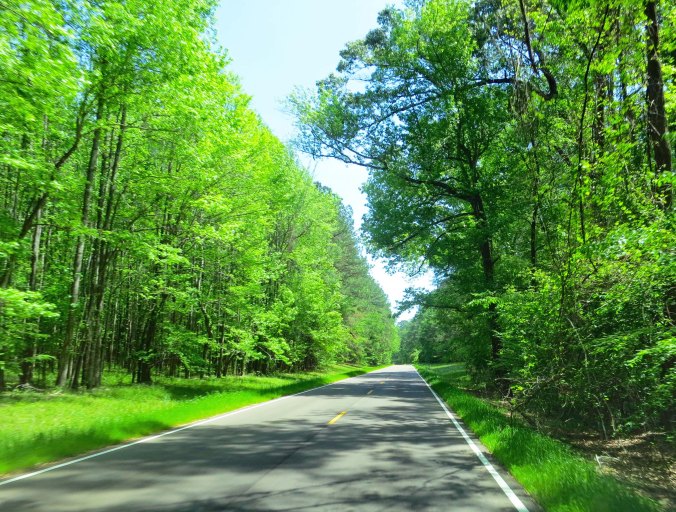
I don’t think there is a place along the Natchez Trace that isn’t beautiful. I traveled on it for 370 miles of its 450 mile length.
This is my fourth post introducing new followers to the type of tales they can find in my blog. Way back in 1989, I did a solo 10,000 mile bicycle tour of North America. While the journey predated blogging, Peggy and I retraced my route three years ago. Traveling out of California, we crossed the US following a southern route, went up the east coast into Canada, headed back west through Canada to Minnesota, and then finished our tour following a northern route back to California. This is a chance to visit much of North America and hear tales about my bike trek. Want more: Here’s a post from Canada. Scroll forward or backward for the rest of the story: https://wandering-through-time-and-place.com/2016/09/28/
A large, yellow mutt came wagging his way into my camp. I’d unpacked my gear, set up my tent, and taken off my shoes and socks. My toes were celebrating their freedom.
“Well hello big fellow,” I said to the dog, glad for the company. He sat down beside me and worked his head under my hand, demanding that I scratch behind his ears. Then I was required to pet the rest of him. I had just worked my way down to his tail when he rolled over and insisted on equal treatment for his tummy.
I provided an initial scratch but my coffee water had started boiling. “Priorities,” I told him, “the petting zoo is closed.” Apparently this meant it was play time. He leapt up, grabbed one of my socks, and bounced off about 15 feet. “Hey! Bring that back,” I urged. Fat chance. He put the sock down, backed off a couple of feet, and started barking.
I finished pouring the hot water into my coffee filter and got up, tiredly, to retrieve my sock. It had been an 80-mile day and I really didn’t want to play ‘chase the dog around the yard.’ I pretended that I didn’t care, that I wasn’t going for the sock, and that I was terribly interested in a large bullfrog that had taken up residence in the swimming pool. The pool hadn’t been cleaned since the previous summer. It made a great pond.
The dog didn’t buy it. He dashed in, grabbed the sock and ran off across the yard. “Okay, you win,” I declared while picking up a stick. “How about a game of chase the stick?” The dog cocked his head and increased his wags per second. I tossed the stick and off he dashed, leaving my sock behind. I quickly bare-footed it across the lawn and grabbed my sock.
“Ha, ha, Mr. Dog,” I called after him while waving the sock about enticingly. To compensate my new friend for his loss, I played tug-of-war with the stick. We growled at each other appropriately, all in good fun.
It was early to bed. I had completed my trip from Alexandria by biking through the city of Natchez and was now camped about a mile from the beginning of the Natchez Trace. I was eager to get up the next morning and start my 370-mile journey up the fabled Parkway through Mississippi and Alabama into Tennessee. As I zipped up my tent, the big yellow mutt did three dog turns outside the door and plopped down, making me wonder where his home was. I was hardly in a position to adopt a pet. Besides, he was well fed and wearing a dog tag.
My last memory before going to sleep was of the bullfrog singing to his lady-love. “Chug-a-rum, chug-a-rum, chug-a-rum.”

Peggy and I drove through Natchez on a Sunday morning and pretty much had the historic section of the downtown to ourselves.
Natchez has an interesting history. Once the site of a major Native American village, its initial contact with Europeans goes all the way back to Hernando de Soto in the mid 1500s. He wandered through the area searching for gold to steal, the primary occupation of Spanish Conquistadores. By the 1700s the French had entered the area followed by the British, the Spanish again, and finally, in 1795, the Americans. Native groups in the region included the Natchez, Chickasaw, Yazoo, Cherokee, and Creek, as well as the Choctaw further to the north.
As for the Natchez Trace, its beginning goes back 10,000 years and was probably tied to buffalo travelling along ridges doing buffalo things. Since these broad, heavy animals make good trails (think of them as early day bulldozers), Native Americans were soon using the routes for trade and travel between large communities.
The next stage in the Trace’s evolution was brought about by river trade in the late 1700s and early 1800s. Kaintucks, boatmen from the Ohio and Mississippi River Valleys, loaded flatboats with merchandise and paddled downstream to Natchez or New Orleans where they made handsome profits for their goods. The challenge was that you don’t row a boat up the mighty Mississippi. The boatmen had to hike or ride horses home. They sold their boats as lumber and made their way back to Nashville via the Natchez Trace
It was an adventure. There is a reason why the Trace became known as The Devil’s Backbone. It was crawling with highway men eager to separate the Kaintucks from their newly earned wealth. And that assumes that they could even get their money out of Natchez where cheap whiskey cost a fortune, hot love was based on cold cash, and cut-throats came by the bushel.
The development of steamboats in the 1820s changed things dramatically. These boats with their large, steam-driven paddle wheels could travel upriver. Boatman no longer had to hike or ride horses back to Nashville while fighting off thieves. Gradually, people stopped using the Trace and it faded from memory. But not totally.
In 1903, the Mississippi chapter of the Daughters of the American Revolution took on a project of placing markers along the original route. In 1918 the precursor to the Natchez Trace Association was created with the rallying cry of “Pave the Trace!” Work on the Parkway was started in 1937 and in 1938 it became a unit of the National Park system.
When I rode my bike out of Natchez in the spring of 1989, the Trace was mainly complete and had become something of a bicyclists’ paradise. (Today it is considered one of the top ten bike rides in America.) To start with, there was no commercial traffic. No 18 wheelers would be whizzing by me. Nor were there any commercial properties or billboards, just lots of beautiful woods and small farms. Campgrounds and restrooms were located conveniently along the way. Frequent rest stops featured local history. I was free to ride along and enjoy the scenery.
But I did have two responsibilities. The first was to persuade the large, yellow mutt that he wasn’t going with me. It started with a discussion in camp that I thought he had understood. Where I was going was dangerous for doggies. It was dangerous enough for me. About a mile from camp I chanced to look back, there he was, about 50 yards back. I stopped and waited for him to catch up, all a waggle. “No!” I said forcefully. “You cannot go. Go Home!” The tail stopped wagging. Two sad brown eyes accused me of horrendous deeds. Ever so slowly, he turned around and started back, tail between his legs. I felt terrible.
The second chore was more pleasant— rescuing baby turtles. Bunches were migrating across the Trace outside of Natchez. Each time I came on a crowd, I would stop, climb off my bike, and give the little tykes a lift across the pavement. I knew that there would be more coming along behind but I must have transported at least a hundred,undoubtedly saving them from being run over.
Following are several photos of the Trace from Natchez to Jackson, Mississippi that I took during the route review Peggy and I did this past spring. In my next blog we will make a slight detour to the town of Philadelphia, Mississippi where a good friend lives and then head up the Trace to Tupelo and visit with Elvis.

The Park has also rebuilt traditional fences similar to ones that the pioneers who lived along the Trace would have built.

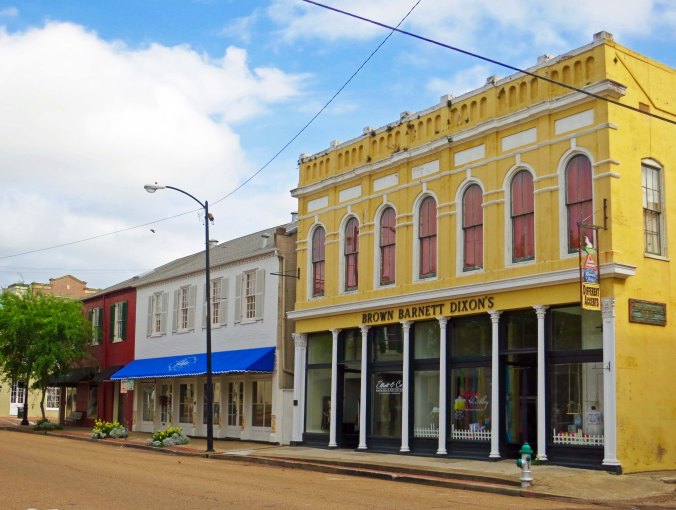







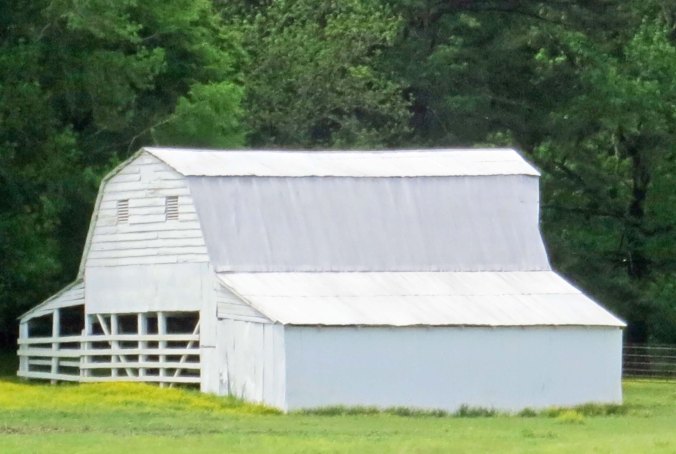
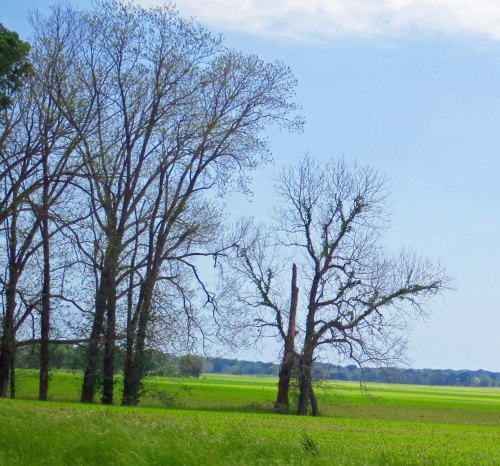

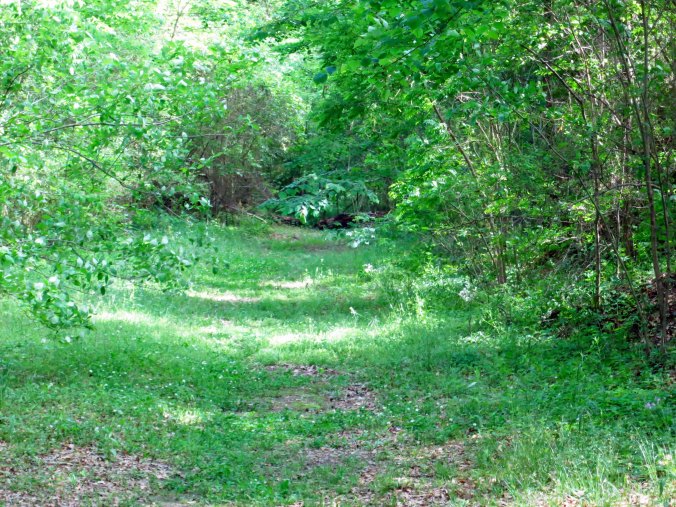

Beautiful country. Natchez Trace looks as well groomed as if the gardener had just left it. Imagine—470 miles of green beauty.
It was a beautiful trail indeed !!
Glad the dog was in the end easily persuaded to leave that sock. The Trace has wonderful history – love that fence.
I was just waiting for it to start chewing! He really just wanted to play. 🙂 Wasn’t the fence neat? There will be more when I blog about the Blue Ridge Parkway. The area is definitely rich in history. –Curt
Curt, it sounds so beautiful. (The nature part, not the rugged challenges of the guys who worked the river.) Maybe one of your top ten bike rides also?
It was certainly one of the top rides of my trip, Bruce. The beauty, history, and hassle free bicycling all captured me. I’ve also driven it several times and it is a favorite of mine from that perspective as well. –Curt
Absolutely beautiful. Is it a bicycle-only trail, or are cars allowed?
Yes it is. It’s mainly cars, Susan, but the speed limit is 55 mph. Except around major cities like Jackson, use is relatively light. –Curt
Just love this Curt – fantastic to read about this treasure. (totally new to me) And extra companions as part of the ride – superb
Thanks Chas. I would have kept the dog! 🙂 As for the Trace, I’ve been over it several times (only once by bike), and it is a very special place. –Curt
Looks really beautiful! Great photos. Looks like you could be in Europe.
Thanks. Quite beautiful. I imagine you would really enjoy it. Very different from what we experience out West. –Curt
Gorgeous photos and I had a chuckle as you painted the picture of the determined pup. I thought perhaps he would come along on the ride still attached. 🙂
Thanks. Maybe I should have had one of those bike trailers to carry him in, Sue. Would have made for many interesting conversations along the way! –Curt
Loved the dog <3. What a beautiful place.
Thanks, Jamie. The dog was a treat, especially considering all of the alone time I spent on my bicycle. Had I been walking, he would have made a great traveling companion. Much beauty! 🙂 –Curt
Looks like both a pleasant town and byway. I don’t see much for shoulders, would you still recommend it for bikers with current traffic?
Nothing in the way of shoulders, Dave. But the lack of commercial traffic and the 55 MPH speed limit made it relatively safe. I certainly didn’t have any problems and the cyclists I saw along it this spring did seem to be enjoying themselves. That being said, there is an occasional bike accident along the highway. Locals jump on it for commute purposes. And like everywhere, there is the occasional drunk driver. –Curt
Natchez looks like a town I’d like to get lost in, with lots of time to explore the antebellum mansions and historic buildings of the American South. -Ginette
It’s an interesting combination of Southern town and river town, Ginette. I really enjoyed the downtown area and how well preserved it has been. –Curt
The nearest thing to touring the States than, well, touring the States. Your attention to detail is phenomenal and the affection shines through …
Nothing like exploring the states and Canada from a bicycle seat, Dave. Unless you walk it. Thanks for the kind words. –Curt
A great trip again and thanks for the wonderful descriptions with photos. I like the architecture of Natchez, especially the details on the verandas and awnings.
Thanks, Gerard. The journey continues! It’s fun that Natchez has preserved its buildings from the 1800s. –Curt
What a delightful ride I just did from the comfort of my couch. I can feel the joy and serenity of it from here. And I’ve long wondered just what is the Natchez Trace. Now I know, though I’m still bewildered by the name. What’s a Trace?
Alison
Trace is just an old-fashioned word for trail, Alison. Glad you are enjoying the ride. Thanks. –Curt
You get chug-a-rums, I get ahhhh-RUMPs. Pacific Northwest bullfrogs are more to the point.
Gorgeous trip. My ass hurts just thinking about it. I’ll leave the cycling marathons to you; If there’s any leisurely beach strolling to be done, I’ll take care of that.
Speaking of which, did a road trip up to the tippy top of Washington the other day and thought of you along a particular stretch of the 101: It was covered in massive madrones!
Southern frogs have a gift of gab and speak in three syllable words.
Tails toughen up quickly out on the road. It’s a do or die thing. But when they complain, boy do they!
Gotta love the madrones. They are such a uniquely neat tree.
BTW: Neighbor has moved. No more baby goats, sigh. Enjoyed hearing from you again. –Curt
Goatieless! Tragic.
It dawns on me that your trip gives new meaning to the phrase “pain in the ass.” I’ll let your significant other fill in the blanks on that one. Hahahaha!
Fortunately, my SO considers me something of an asset as opposed to an ass. 🙂 Plus as they say, “It only hurts for a little while.” Then you become hard-assed? Missing goats much. –Curt
Hahahaha!
Have some goaties on me:
https://www.youtube.com/watch?v=QL6Ws4i07is
Thanks… 🙂
I’m just amazed. I really haven’t known any more about the Natchez Trace than its name. I didn’t know exactly where it was, where it went, or what attractions it might offer. Once I traced the Trace, it all became clear.
My time in Mississippi has been west of the Trace: route 61 through the Blues country, Oxford, Bolivar and other sites related to the Civil War. I came into the state through Vicksburg, and followed the river north to where my gr-gr-grandfather started his Civil War service, in the Yazoo Pass expedition. If I ever decide to do my southern literary tour, following the Trace would be perfect.
As always, a wonderful read. I must confess I felt bad for the dog. Some things just have to be, but I’ll bet he would have been a great companion. It’s better, knowing he had tags.
Thanks. I’ve been over the Trace several times Linda. It’s my preferred mode of travel when I am in the area.
Interestingly, I am presently reading a book on the Civil War and am just about to the battle of Vicksburg.
Under different circumstances, the dog and I would have ridden off into the sunset together. –Curt
Everything is so wonderfully GREEN! Interesting history, too.
Thanks, Lex. Year around green always seems strange when you come from the West like I do. 🙂 –Curt
As always enjoying traveling the country and our history and all lhe beauty!
Thanks, Jane. It is always fun to share my stories with you, as I have for 40 years. 🙂 –Curt
Rescuing baby turtles — now that could be a never-ending job! Glad you reached the Trace — no 18-wheelers. Just beautiful scenery. Your trip is amazing.
After a while, I confess to wishing them good luck on their journey. 🙂 And thanks. The trip was definitely one of those once in a life time events. –Curt
This was a particularly good one. The dog, the Trace, the turtles. And what scenery! I’ve got this one on my list of places to visit, and your blog makes me want to go even more than I did before.
The dog was a sweetheart, Crystal. And the Trace is beautiful. I’ve been back on it several times since at different times of the year. It’s always gorgeous. Thanks. –Curt
As a biker myself, I eye the road and note….there is no shoulder at all.
One of the few places I didn’t need it Craig. No commercial vehicles and 45 mph speed limits made it a dream! There were plenty of places where that wasn’t true. I am sure that you appreciate having about five inches and trucks roaring by at 65! –Curt
A solo 10,000 mile bicycle tour of North America. I knew you weren’t real, Curt.
What a trail. Beautiful.
Some of those hundred mile days felt pretty real, Bojana! Ask my tailbone. (grin) Thanks. –Curt
Lol. I bet. But you did it. That’s what counts.
If you did the whole Trace, you passed right by my daughter’s place in Tennessee.
I may have missed your daughters place on the bike trip, Lulu. I cut off in the southern part of the state to bicycle eastward to the Smokey Mountains. I’ve driven the road several times, however. So I have passed your daughters house! –Curt
I remember this series, nice to see a bit of it again.
Peggy and I loved the trip, Andrew. It was a lot of fun remembering my bike trip. Thanks. –Curt
Great story! I really liked it ♥
Jane
Thanks, Jane. Glad you stopped by and enjoyed my tale. –Curt
Just a note, Curt. I didn’t receive an email for this post. If I hadn’t happened to be taking a look at the reader for another reason, I would have missed it. Did you re-post using the same title, by any chance? From what I understand, that can prevent a second email from being sent.
I think you are right, Linda. Normally I change names. This time I didn’t. –Curt
How pretty! Boy the adventures you’ve managed! Well done, love how green it is!
The Trace was special to me, not only for its beauty but also for its lack of commercial traffic and low speed limits. I travelled down a lot of dangerous roads in 10,000 miles. It was a delight to be able to relax, MB. –Curt
I drove a little bit of the Natchez Trace in Mississippi, but would love to see more of it. Probably not on a bicycle, but I would definitely get out of the car and explore a little more.
It’s a delight to bicycle, Juliann. (Not so much when I had to hide out in a brick outhouse to avoid a tornado!) –Curt
My hat! Congratulations for this 10,000 mile bicycle tour of North America. It is incredible. It was maybe in 1973, when I visited in Penedo (little Finland), Brazil where they told me about a Finn who cycled round the world. Your mile reading is unforgettable to me. Thank You for this post.